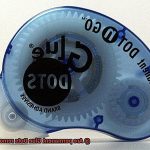Picture a world where injuries and wounds fearlessly defy water’s intrusion, healing effortlessly even in the most unforgiving aquatic domains. In the realm of medical breakthroughs, innovation has always been our guiding light, reshaping how we tackle injuries. Today, we embark on an exhilarating journey to explore the enchanting topic that revolves around the seemingly mystical powers of glue stitches — their ability to repel water.
Gone are the days when traditional sutures held a monopoly on wound sealing. In this blog post, we set out on an adventure into the captivating universe of glue stitches, addressing the burning question that lingers in every curious mind: Can these adhesive wonders withstand the relentless forces of water?
Come along as we plunge deep into the world of adhesive healing, unraveling the truth behind the waterproof prowess of glue stitches. Brace yourself for astonishment as we uncover how these seemingly ordinary adhesives might just be the key to unlocking a whole new era of water-resistant wound closures.
What are Glue Stitches?
Contents
- 1 What are Glue Stitches?
- 2 Properties of the Adhesive Used in Glue Stitches
- 3 Are Glue Stitches Waterproof?
- 4 How Long Can Glue Stitches Withstand Water Exposure?
- 5 Different Types of Glue Stitches and Their Water Resistance
- 6 When Should You Avoid Submerging a Wound with Glue Stitches?
- 7 Factors That May Affect the Water Resistance of Glue Stitches
- 8 How to Protect Against Water Damage for Wounds with Glue Stitches
- 9 Conclusion
Glue stitches have emerged as a convenient and effective alternative to traditional sutures for wound closure. The use of medical-grade adhesive in glue stitches offers several advantages, including quick application, minimal scarring, and the elimination of suture removal. However, one burning question remains: Are glue stitches waterproof? In this article, we will delve into the properties of glue stitches and explore their water resistance capabilities.
Properties of Glue Stitches:
Glue stitches, also known as adhesive sutures or tissue adhesives, employ a special medical-grade adhesive made from substances like cyanoacrylate or octyl-2-cyanoacrylate. This adhesive forms a thin, flexible film over the wound, bonding the edges together and facilitating the healing process.
Water Resistance of Glue Stitches:
While glue stitches offer some degree of water resistance, they are not completely waterproof. The adhesive used in glue stitches forms a protective barrier over the wound that helps prevent water from seeping in. This is beneficial for activities such as showering or washing hands. However, prolonged exposure to water, like swimming or soaking in a bath, can compromise the adhesive bond and increase the risk of wound dehiscence.
Enhancing Water Resistance:
To enhance the water resistance of glue stitches, healthcare professionals may apply a thin layer of waterproof dressing or film over the adhesive. This additional barrier provides extra protection against water penetration during activities involving prolonged exposure to water.
Choosing the Right Wound Closure Method:
It’s important to note that glue stitches are not suitable for all types of wounds. They are primarily used for superficial lacerations or incisions with clean edges that can be easily approximated. Wounds with jagged or uneven edges may require additional sutures or staples for proper closure.
Consultation with Healthcare Professionals:
When it comes to wound care, it is always best to consult with a healthcare professional for proper instructions and advice. They can assess the nature of the wound and determine whether glue stitches are suitable. They can also provide guidance on wound care, including precautions to take regarding water exposure.
Properties of the Adhesive Used in Glue Stitches
The adhesive used in glue stitches is like a magical potion that holds your skin together when you get a cut. Let’s dive into the properties of this mysterious adhesive and unlock its secrets.
First and foremost, the adhesive used in glue stitches is typically a medical-grade cyanoacrylate adhesive. This adhesive is renowned for its ability to form a strong bond with the skin and its quick curing time. It works its magic by holding the wound edges together, promoting healing, and preventing further damage.
One of the standout properties of cyanoacrylate adhesives is their water resistance. Once fully cured, they create a waterproof barrier that shields the wound from moisture. So feel free to jump into that refreshing shower without worrying about compromising the integrity of your glue stitches. However, it’s important to remember that while glue stitches are water-resistant, they are not completely waterproof. Prolonged exposure to water can still weaken the adhesive bond, so it’s best to avoid swimming or soaking in water for an extended period of time.
Flexibility is another remarkable property of cyanoacrylate adhesives. Even after curing, the adhesive remains flexible, allowing for movement and minimizing discomfort for the patient. This flexibility also helps accommodate any swelling that may occur around the wound area.

But wait, there’s more. Cyanoacrylate adhesives are hypoallergenic and have low toxicity, making them safe for use on most individuals. However, it’s always essential to consult with a healthcare professional before using glue stitches, especially if you have any known allergies or sensitivities.
Are Glue Stitches Waterproof?
Glue stitches, also known as adhesive or liquid stitches, have revolutionized wound closure with their convenience and flexibility. But are these magical adhesive stitches truly waterproof? Let’s dive into the fascinating world of glue and find out.
The main component of glue stitches is a medical-grade adhesive that forms a strong bond with the skin. This bond creates a barrier that prevents water from penetrating the wound, making glue stitches generally water-resistant. So yes, you can confidently shower or take a dip in the pool without worrying about your stitches coming off.
However, it’s important to note that not all glue stitches are created equal in terms of water resistance. Factors like the type and location of the wound, the quality of the adhesive used, and individual variations in skin type and healing process can affect their ability to withstand water. In some cases, excessive moisture or prolonged exposure to water may cause the glue stitches to loosen or come off prematurely.
To ensure optimal healing and minimize the risk of complications, it’s crucial to follow proper wound care instructions provided by a healthcare professional. They may recommend additional protective measures like waterproof bandages or dressings in situations where there is a high likelihood of water exposure, such as swimming or participating in water sports.
So, while glue stitches offer convenience and flexibility compared to traditional sutures, it’s important to exercise caution when exposing them to water. Consult with a healthcare professional before indulging in aquatic adventures to ensure your wound heals with minimal issues. Let the magic of glue stitches work its wonders on your healing journey while keeping you protected from unwanted water-related concerns.
How Long Can Glue Stitches Withstand Water Exposure?
Imagine facing the dilemma of choosing between skipping a refreshing shower or putting your precious glue stitches at risk. Fear not, dear readers. Today, we embark on an exploration into the captivating world of glue stitches to uncover their ability to withstand water exposure. So grab a towel and prepare for a deep dive into the truth.
Water-Resistant, yet Not Waterproof:
Glue stitches, also known as adhesive stitches or tissue adhesive, are a modern marvel in wound closure. These medical-grade glues are designed to seal wounds, creating a secure and flexible barrier against external elements. However, it’s crucial to note that glue stitches are not completely waterproof, despite their water-resistant nature.

The Duration Dilemma:
How long can glue stitches hold up against water exposure? The answer lies within various factors such as the type of adhesive used, the size and location of the wound, and individual healing characteristics. Generally speaking, most medical-grade adhesives can endure brief encounters with water – like showering or handwashing. Nevertheless, prolonged exposure to water, such as swimming or soaking in a bathtub, may undermine the effectiveness of glue stitches.
Heeding Expert Advice:
To ensure proper healing and minimize complications, it is vital to follow healthcare professionals’ instructions diligently. They may offer specific guidelines tailored to your unique circumstances. In the event that your glue stitches accidentally get wet, gently pat them dry with a clean towel. Avoid any rubbing or scrubbing actions that could disrupt the adhesive bond and increase the risk of wound reopening.
Not a One-Size-Fits-All Solution:
While glue stitches prove impressive for many wounds, they may not be suitable for all injuries. Deep cuts, wounds under tension, or those in high-mobility areas may necessitate traditional sutures or alternative closure methods for optimal healing. Remember, consulting a healthcare professional is always the best course of action to determine the most appropriate treatment option for your specific wound.
Different Types of Glue Stitches and Their Water Resistance
Cyanoacrylate glue, also known as “super glue,” is the superhero of glue stitches. It forms an unbreakable bond that can withstand the relentless assault of water droplets. But even superheroes have limits. While cyanoacrylate glue is highly water-resistant, prolonged exposure to water can weaken its hold. So, when it comes to swimming sessions, keep them short to ensure your wound remains protected.
Octylcyanoacrylate Glue
Octylcyanoacrylate glue is the acrobat of adhesive stitches. It provides a flexible yet secure closure for wounds. Like its counterpart, cyanoacrylate glue, octylcyanoacrylate offers excellent water resistance. So, whether you’re splashing around in the pool or enjoying a beach day, rest assured that your wound will stay protected.
Additional Ingredients for Extra Protection
Some glue stitches go above and beyond their water resistance powers by including antimicrobial agents. These agents act as guardians against sneaky infections that try to invade your wound during watery adventures. Think of it as an extra layer of armor for your wound’s superhero suit.
Not Completely Waterproof
While glue stitches are generally water-resistant, they are not invincible against water. Don’t expect them to endure underwater expeditions in your bathtub or marathon swim sessions. Remember, even superheroes take precautions.
Proper Care Instructions for Glue Stitches
To maintain the water resistance of your glue stitches, it’s essential to follow proper care instructions from healthcare professionals or product manufacturers. Keep your wound clean and dry, avoid putting excessive strain on it, and seek medical attention if you notice any signs of infection or complications. By following these instructions, you become the responsible sidekick in your wound’s healing journey.
Consider Additional Protection
If you want to enhance your wound’s water resistance, consider using waterproof dressings or bandages. These act as a shield, providing an extra layer of defense against water attacks. Think of them as your wound’s personal bodyguard, protecting it from any unexpected encounters with water.
When Should You Avoid Submerging a Wound with Glue Stitches?
Glue stitches, also known as cyanoacrylate glue, have gained popularity as an alternative to traditional stitches for wound closure. They offer a quick and painless way to seal wounds, but it’s essential to understand that not all wounds are suitable for submersion. In this article, we will discuss the situations where avoiding submerging a wound with glue stitches is recommended.
Wounds Exposed to Moisture or Sweat:

Moisture and excessive sweating can compromise the adhesive properties of glue stitches, leading to their loosening or detachment. Areas such as the hands, feet, or groin are particularly prone to sweating, making it advisable to avoid submerging wounds in water until they have fully healed.
Deep Wounds or High Risk of Infection:
If a wound is deep or has a high risk of infection, glue stitches may not provide adequate support or protection. Deep wounds often require medical attention, such as stitches or sutures, to ensure proper closure and reduce the risk of complications. Submerging these wounds in water can increase the risk of infection and hinder the healing process.
Difficult-to-Clean Areas:
Wounds located in areas that are difficult to keep dry or clean should be treated with caution when using glue stitches. Moisture trapped under the glue can create a breeding ground for bacteria, potentially leading to infection. It is crucial to keep these wounds clean and dry to facilitate proper healing.
Factors That May Affect the Water Resistance of Glue Stitches
Now, let’s take a deep dive into the world of glue stitches and explore the factors that can affect their water resistance. Just like choosing the perfect swimming gear for a pool party, understanding these factors is crucial for making informed decisions about using glue stitches in water-related activities. So, let’s jump right in.
Type of Glue Used:
Different glue types offer varying levels of water resistance. Cyanoacrylate-based glues, like superglue, are renowned for their water-resistant properties and are often used in medical settings. These powerful adhesives form a tight bond that can withstand exposure to water. However, certain craft or epoxy glues may not hold up as well against moisture. Knowing the specific type of glue used is essential for assessing its water resistance capability.
Application Technique:
Proper application is key. Before applying glue stitches, it’s important to thoroughly clean and dry the wound area. Any moisture or debris can interfere with the adhesive properties. Additionally, ensuring adequate coverage of the wound and an even application will boost water resistance. Remember, a strong bond is vital in keeping those glue stitches intact.
Wound Location:
Consider where your wound is located – some areas are more prone to moisture or friction (hello, sweaty palms.). Joints or areas exposed to constant moisture may present challenges in maintaining water resistance. In such cases, additional protective measures like waterproof dressings or sealants can do wonders.
Duration and Intensity of Water Exposure:
Just like a long swim can make our fingers wrinkle, prolonged exposure to water weakens glue stitches too. Activities like swimming or bathing put them to the test. Moreover, hot water or chemicals such as chlorine or saltwater can compromise their water resistance. Following healthcare professionals’ instructions on care and maintenance is crucial for optimal performance.
Individual Factors:
We’re all unique, and so are our skin types and healing processes. People with oilier skin or those who sweat more may find it challenging to maintain water resistance. Likewise, individuals with specific conditions or delayed wound healing may require extra precautions. Always consider these individual factors when assessing the suitability of glue stitches.
How to Protect Against Water Damage for Wounds with Glue Stitches
Here, we’ll explore how to protect your glue stitches from water damage so you can heal properly and avoid complications. Let’s dive in.
Avoid Submerging the Wound:
To safeguard your glue stitches, it’s crucial to avoid submerging the wound in water until it’s fully healed. This means skipping baths and swimming until your healthcare provider gives you the green light. Instead, opt for quick showers to minimize water exposure.
When water seeps into a wound with glue stitches, it can weaken the adhesive and compromise the wound closure. This increases the risk of infection and delayed healing. By avoiding submersion, you can protect the integrity of the glue stitches and promote proper healing.
Use a Waterproof Bandage or Dressing:
Covering your wound with a waterproof bandage or dressing is an excellent way to protect against water damage. These specialized coverings create a barrier that prevents water from directly contacting the wound. Make sure to change the bandage regularly and keep the area clean and dry.
Waterproof bandages and dressings are designed to be breathable while providing effective protection against moisture. They are available in various sizes and shapes to accommodate different wound areas. By using these products, you can keep your glue stitches dry and reduce the risk of complications.
Shower Smartly:
When showering, take care not to direct the water stream directly onto the wound. Position yourself carefully or use a waterproof arm or leg sleeve to keep the wound area away from direct contact with water. This simple step can help minimize the risk of water seeping into the wound and compromising the adhesive.
Showering smartly involves being mindful of the water flow and its impact on your wound. By redirecting the stream or using protective sleeves, you can ensure that water doesn’t come into direct contact with your glue stitches. This precautionary measure is especially important during the early stages of healing when the adhesive may not be fully set.
Gently Pat Dry:
After showering or any exposure to water, gently pat the wound dry with a clean towel or sterile gauze. Avoid rubbing or applying excessive pressure, as this can disrupt the glue stitches. Remember, gentle patting is key to keeping the area clean and dry.
When drying your wound, it’s essential to be gentle to avoid disturbing the glue stitches. Patting helps absorb excess moisture without causing unnecessary trauma to the wound. By practicing gentle patting, you can maintain the integrity of the adhesive and promote optimal healing.
7O85r-lwkKM” >
Conclusion
In conclusion, glue stitches are not inherently waterproof.
While they can provide some level of water resistance, they are not completely impervious to moisture. It is important to keep in mind that the effectiveness of glue stitches in wet conditions can vary depending on factors such as the type of adhesive used and the specific application technique.
Therefore, if you are relying on glue stitches for a waterproof seal, it is advisable to take additional precautions such as using waterproof dressings or avoiding prolonged exposure to water.






